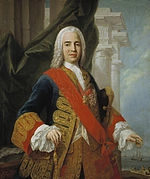How to Pronounce Zenón de Somodevilla, 1st Marquess of Ensenada
#50
Most Popular
Boost
Apr 20, 1702 Alesanco, La Rioja, Spain Died on 02 Dec 1781 (aged 79)
Spanish noble
TaurusZenón De Somodevilla 1st Marquess Of Ensenada, Date of Birth, Place of Birth, Family, Facts, Age, Net Worth, Biography and More in FamedBorn.com

Spanish noble
Taurus